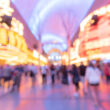Fremont Street, the pulsating heart of Downtown Las Vegas, is more than just a vibrant pedestrian mall covered by a dazzling LED canopy. It’s where the story of Sin City began, a place steeped in history, neon, and a gritty charm that sets it apart from the glitzy Las Vegas Strip. While many visitors flock to Fremont Street for its free concerts, SlotZilla zipline, and iconic Viva Vision light shows, there are lesser-known facets of this legendary street that reveal its deep cultural and historical significance. Here are the top 10 things you didn’t know about Fremont Street, offering a fresh perspective on this iconic destination.
1. Fremont Street Was the Birthplace of Las Vegas
Fremont Street is where Las Vegas as we know it began. Established in 1905, the same year the city was founded, it was named after John Charles Frémont, a famed explorer and politician who mapped much of the American West. The street quickly became the epicenter of the fledgling city, with the first train station built at the intersection of Main and Fremont in 1905, initially using a repurposed train car. By 1906, a Spanish Mission-style depot welcomed travelers, setting the stage for Fremont Street to become the hub of business, gambling, and entertainment. Unlike the Strip, which emerged decades later, Fremont Street was the original Las Vegas, catering to early settlers, railroad workers, and thrill-seekers.
2. It Was Home to Nevada’s First Casino
In 1906, the Hotel Nevada (later renamed the Golden Gate Hotel & Casino) opened its doors on Fremont Street, marking it as the site of Las Vegas’s first hotel and casino. This establishment also housed the city’s first telephone in 1907, a testament to its role as a pioneer in the region’s development. By 1931, the Northern Club at 15 E. Fremont Street became the first to receive a Nevada gaming license, cementing Fremont Street’s status as the birthplace of legal gambling in the state. These early establishments laid the foundation for iconic casinos like Binion’s Horseshoe, the Golden Nugget, and the Four Queens, many of which still operate today.
3. Fremont Street Was the First Paved Street in Las Vegas
In 1925, Fremont Street earned another first: it became the city’s first paved street, a significant milestone in a desert town where dirt roads were the norm. This development made it easier for visitors and locals to navigate the bustling corridor, which was already becoming known for its gambling halls and vibrant nightlife. The street also received Las Vegas’s first traffic light in 1931, further solidifying its role as the city’s central artery. These infrastructural advancements helped Fremont Street maintain its prominence as the go-to destination for entertainment long before the Strip’s mega-resorts emerged.
4. It Was Known as “Glitter Gulch” for Its Neon Signs
In the 1930s, Fremont Street’s casino district earned the nickname “Glitter Gulch” due to its dazzling array of neon signs. The Las Vegas Chamber of Commerce coined the term to highlight the street’s unique blend of Old West aesthetics and vibrant neon, a stark contrast to the more subdued signage of the era. Iconic signs like Vegas Vic, the 40-foot-tall neon cowboy erected in 1951, and Vegas Vickie, the cowgirl installed in 1980, became symbols of this era. Vegas Vic, once the world’s largest mechanical neon sign, greeted visitors with a glowing “Howdy Podner” and remains a beloved landmark at the Pioneer Gift Shop. The Neon Museum, located nearby, preserves these historic signs, offering a glimpse into Fremont Street’s neon-drenched past.
5. Fremont Street Was a Mobster Hangout
Fremont Street’s history is intertwined with the mob, a fact that adds to its gritty allure. In the mid-20th century, casinos like the El Cortez, opened in 1941, and the Golden Nugget were frequented by mob figures who played a significant role in shaping Las Vegas. The El Cortez, for instance, was once owned by notorious mobsters like Bugsy Siegel before he developed the Flamingo on the Strip. The street’s casinos were hotspots for the Rat Pack—Frank Sinatra, Dean Martin, and Sammy Davis Jr.—who performed and partied there, adding a layer of glamour to its underworld reputation. The Mob Museum, just a short walk from Fremont Street, offers a deep dive into this era, with exhibits on the mob’s influence on Las Vegas’s early gambling scene.
6. It Was Transformed into a Pedestrian Mall in the 1990s
By the 1980s, Fremont Street was losing visitors to the glitzy Strip, prompting a bold revitalization effort. In 1994, the street was closed to vehicle traffic and transformed into a pedestrian mall, officially becoming the Fremont Street Experience in 1995. The centerpiece of this transformation was the Viva Vision canopy, a 1,375-foot-long LED screen spanning five blocks, making it the world’s largest video display with 49.3 million LED lights. The canopy, completed in 2004, features nightly light and sound shows with music from artists like Shakira and Imagine Dragons, drawing millions of visitors annually. This reinvention turned Fremont Street into a modern entertainment hub while preserving its vintage charm.
7. The SlotZilla Zipline Is the World’s Largest Slot Machine
One of Fremont Street’s most thrilling attractions is the SlotZilla zipline, which launches riders from a 12-story structure designed to resemble a giant slot machine. Opened in 2014, SlotZilla offers two experiences: the lower Zipline (850 feet, seated) and the upper Zoomline (1,750 feet, superhero-style). The attraction not only provides an adrenaline rush but also serves as a “customer delivery system” for downtown casinos, boosting foot traffic. Interestingly, casino mogul Steve Wynn is among those who have taken the ride, a surprising tidbit given his association with the Strip’s high-end resorts. SlotZilla has become a defining feature of the Fremont Street Experience, blending modern thrills with the street’s playful spirit.
8. Fremont Street Has Been a Hollywood Star
Fremont Street’s vibrant atmosphere and neon glow have made it a popular filming location for movies, TV shows, and music videos. The 1971 James Bond film Diamonds Are Forever featured a chase scene with Bond side-rolling a car through an alley onto Fremont Street. U2’s 1987 music video for “I Still Haven’t Found What I’m Looking For” captured the band wandering the street, while The Weeknd filmed parts of his 2019 videos for “Heartless” and “Blinding Lights” there. The 2024 Academy Award-winning film Anora was also shot at the Fremont Street Experience. Additionally, Fremont Street appears in pop culture as “Freeside” in the 2010 video game Fallout: New Vegas, depicted as a post-apocalyptic slum, and as “The Old Las Venturas Strip” in Grand Theft Auto: San Andreas. These appearances highlight its enduring cultural significance.
9. The Golden Nugget Houses the World’s Largest Gold Nugget
The Golden Nugget, one of Fremont Street’s oldest casinos (opened in 1946), is home to the “Hand of Faith,” the world’s largest gold nugget, weighing 62 pounds. Discovered in Australia in 1962, this massive nugget is displayed in the casino’s lobby, drawing crowds eager to see a piece of natural treasure. The Golden Nugget also features a 200,000-gallon shark aquarium, where visitors can view marine life up close, take a guided tour, or even ride a waterslide through the tank. These unique attractions make the Golden Nugget a standout destination on Fremont Street, blending history with spectacle.
10. Fremont Street’s Street Performers Are Highly Competitive
The street performers who add to Fremont Street’s electric atmosphere aren’t just random buskers—they compete for coveted spots through a lottery system. With only about 30 two-hour performance slots available daily, artists, musicians, and costumed characters must apply and vie for the chance to perform. This competitive process ensures a high level of creativity, with performers often crafting original, handmade costumes to stand out. However, the street’s open nature has led to controversy, as a 2019 sting revealed some costumed characters were registered





